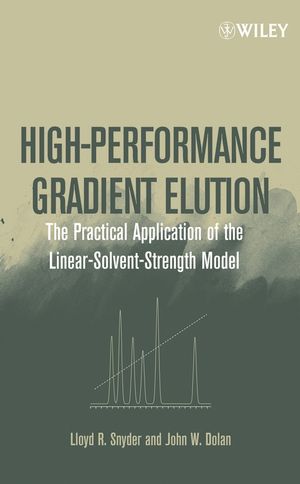High-Performance Gradient Elution: The Practical Application of the Linear-Solvent-Strength ModelISBN: 978-0-471-70646-5
Hardcover
496 pages
December 2006
 This is a Print-on-Demand title. It will be printed specifically to fill your order. Please allow an additional 10-15 days delivery time. The book is not returnable.
|
||||||
GLOSSARY OF SYMBOLS AND TERMS.
1 INTRODUCTION.
1.1 The “General Elution Problem” and the Need for Gradient Elution.
1.2 Other Reasons for the Use of Gradient Elution.
1.3 Gradient Shape.
1.4 Similarity of Isocratic and Gradient Elution.
1.5 Computer Simulation.
1.6 Sample Classification.
2 GRADIENT ELUTION FUNDAMENTALS.
2.1 Isocratic Separation.
2.2 Gradient Separation.
2.3 Effect of Gradient Conditions on Separation.
2.4 Related Topics.
3 METHOD DEVELOPMENT.
3.1 A Systematic Approach to Method Development.
3.2 Initial Experiments.
3.3 Developing a Gradient Separation: Resolution versus Conditions.
3.4 Computer Simulation.
3.5 Method Reproducibility and Related Topics.
3.6 Additional Means for an Increase in Separation Selectivity.
3.7 Orthogonal Separations.
4 GRADIENT EQUIPMENT.
4.1 Gradient System Design.
4.2 General Considerations in System Selection.
4.3 Measuring Gradient System Performance.
4.4 Dwell Volume Considerations.
5 SEPARATION ARTIFACTS AND TROUBLESHOOTING.
5.1 Avoiding Problems.
5.2 Method Transfer.
5.3 Column Equilibration.
5.4 Separation Artifacts.
5.5 Troubleshooting.
6 SEPARATION OF LARGE MOLECULES.
6.1 General Considerations.
6.2 Biomolecules.
6.3 Synthetic Polymers.
7 PREPARATIVE SEPARATIONS.
7.1 Introduction.
7.2 Isocratic Separation.
7.3 Gradient Separation.
7.4 Severely Overloaded Separation.
8 OTHER APPLICATIONS OF GRADIENT ELUTION.
8.1 Gradient Elution for LC-MS.
8.2 Ion-Exchange Chromatography.
8.3 Normal-Phase Chromatography.
8.4 Ternary- or Quaternary-Solvent Gradients.
9 THEORY AND DERIVATIONS.
9.1 The Linear Solvent Strength Model.
9.2 Second-Order Effects.
9.3. Accuracy of Gradient Elution Predictions.
9.4 Values of S.
9.5 Values of N in Gradient Elution.
Appendix I: THE CONSTANT-S APPROXIMATION IN GRADIENT ELUTION.
Appendix II: ESTIMATION OF CONDITIONS FOR ISOCRATIC ELUTION, BASED ON AN INITIAL GRADIENT RUN.
Appendix III: CHARACTERIZATION OF REVERSED-PHASE COLUMNS FOR SELECTIVITY AND PEAK TAILING.
Appendix IV: SOLVENT PROPERTIES RELEVANT TO THE USE OF GRADIENT ELUTION.
Appendix V: THEORY OF PREPARATIVE SEPARATION.
Appendix VI FURTHER INFORMATION ON VIRUS CHROMATOGRAPHY.
Index.



